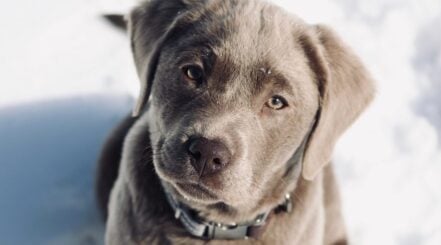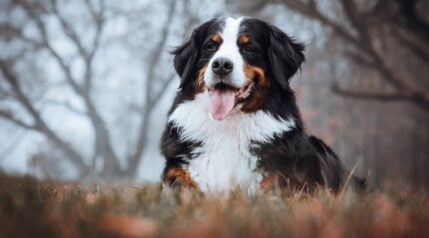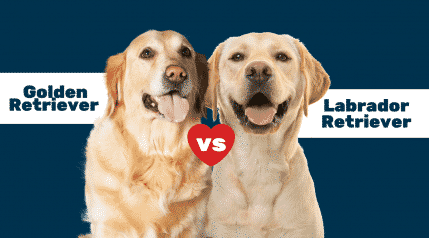Are you comparing the Newfoundland vs. Labrador Retriever for your next canine companion? Newfoundlands and Labradors are both loved by their owners and respected by the dog-loving community at large. They’re intelligent breeds valued for their hardworking nature and loving demeanor, great for families and growing children.
But these breeds have many differences. In fact, while their temperaments can sometimes be similar, that’s about where it stops. Labrador Retrievers are great dogs for first-time dog owners, and Newfoundlands are not. It’s important to understand what each breed brings to the table before figuring out which one is best for your family and living situation.
So, whether you’re trying to decide between Newfoundland vs. Labrador puppies, or just curious about how they compare, this article will help. Here, you’ll learn all about the breeds’ histories, appearances, health, and more. Let’s jump in and learn all about these two breeds before you pick one as your next furry friend!
Breed Comparison
Newfoundland
- Height 27-29 Inches
- Weight 100-150 Pounds
- Temperament Friendly, Calm, Independent
- Energy Relaxed
- Health Average
- Lifespan 8-10 Years
- Puppy Prices $2,000 and Up
Labrador Retriever
- Height 21-24 Inches
- Weight 55-80 Pounds
- Temperament Friendly, Hardworking, Intelligent
- Energy Energetic
- Health Above Average
- Lifespan 13-14 Years
- $1,000 and Up Puppy Prices
Breed History
The histories of both the Newfoundland and Labrador Retriever are fascinating. Innately tied with Canada’s colonization, their stories span the Atlantic ocean and two continents, Europe and North America. Both breeds are extremely popular as working dogs, and family pets. Let’ take a look at a quick overview of each breed’s history.
Newfoundland

The Newfoundland’s (also known as the Newfie) exact origins are unknown to even the most thorough historians. However, the breed as we know it today comes from dogs brought to England from the island of Newfoundland, Canada, in the 1800s.
There are a few theories as to where those original dogs from Newfoundland came from. The most basic one is that they resulted from frequent interbreeding by European explorers and colonizers in the 1500s and 1600s, purposed for working in the docks developed at the time.
The second theory is that they derive their lineage from the Black wolf or other native dogs to the region. However, there aren’t any records that the Native peoples to Newfoundland possessed Black wolves or have a history of taming them, and it would take a long time for the wolves to turn into dogs.
More likely is that the original dogs were brought over from Europe by Vikings in the early 1000s. There is evidence of Viking settlements in Newfoundland, and it would explain how Native peoples came to possess dogs with similar genetic heritage to those found in Europe at the time.
Through the 19th century, Newfoundland dogs began to increase in popularity throughout the island, coming back from the brink of extinction during the 1700s. Their work ethic and burly strength made them valuable to many working men and women, used for various tasks around the dock and through towns and villages.
Once people imported Newfoundlands to England, their popularity began to skyrocket. Today, they’re considered valuable companions for families but rarely used as working dogs as they once were.
Labrador Retriever

Labrador Retrievers also come from Newfoundland, contrary to being named after the neighboring Labrador island. Labs and Newfoundlands are not related, but the Kennel Club them both recognized as official breeds around the same time.
Labradors derive their lineage from the St. John’s water dog, a valuable working dog in Newfoundland that excelled at swimming and was known for its intelligence. The first recordings of these dogs are in the early 1500s during the region’s French and British colonization.
The St. John’s water dog was the best at what it did, which was fetching fishing lines, diving after fish, and even bringing in entire fishing nets on its own. Fishers and farmers in the area praised the breed for its work ethic and often raised puppies to trade and sell to other workers.
In the 1800s, the water dog finally left Newfoundland’s shores and traveled to England, where royals valued the breed for its potential for cross-breeding. Collaboration between breeders eventually evolved the fishing dog into a hunting dog, and the Labrador was born.
As traders exchanged the breed back and forth between the Old and New Worlds, it gained a reputation for being a fantastic work dog, not just in water but also on land. It was an excellent swimmer but also a great watchdog on farms around the globe.
Today, the Labrador is consistently one of the most popular dog breeds in England and the US. There are both field and bench Labs, which are typically are bred for different purposes. Households regularly add Labs to the family, and people value them as great pets.
Appearance

Although they share the same place of origin, the Newfoundland and Labrador breeds look very different. Labs are generally considered a medium to large sized dog, with males weighing 65 to 80 pounds and females around 55 to 70 pounds. They stand at 21 to 24 inches, considered the low end of large dogs. Because of their family-friendly nature, they are often compared by potential dog owners to other family-friendly breeds.
Newfoundlands, on the other hand, are veritable giants. Males can weigh up to 150 pounds, while females typically weigh anywhere between 100 to 120 pounds. The breed stands at about 27 to 29 inches, much taller than most other dog types. Because of their size and fluffy coats, they are often compared to the Pyrenees and other large and thick-coated breeds.
Both Labs and Newfies can vary in color. Labradors have three officially recognized colors, black, yellow, and chocolate. There are other variants, but Kennel Clubs do not formally recognize them in the US or UK.
Newfoundlands can come in gray, brown, black, and black and white. However, most people think of Newfoundlands as black, and this is the predominant color you might see online and in person.
Temperament

Labs have developed a reputation as being a pretty mischievous dog breed. Although extremely friendly, smart, and loyal, they tend to retain their energetic habits well into adulthood. They’re great with children and make fantastic pets for a growing family.
Newfies are generally more laid back. Although most have enough energy to play around for a while, they aren’t nearly as frantic as Labs can be. Many people consider them to be gentle and calm, radiating their intelligence from their doggie bed whenever possible.
Both breeds are excellent watchdogs. They’re loyal to their families and are ready to alert them to any danger. Labs, however, tend to be more trusting than their Newfie counterparts. Their friendly nature can sometimes get the best of them, which in most cases is precisely the trait dog owners look for in their pets.
Exercise

All dogs need exercise, no matter the breed. Obesity is a common issue among different breeds, and activity is one of the best ways of preventing it.
Between the two, Labradors are much easier to keep healthy and active through exercise. They’re already very high-energy and more than willing to go for a run or swim whenever it’s possible. In total, a Lab should be kept active for about two hours every day to keep them mentally and physically fit.
Newfoundlands are a bit harder to motivate. Although traditionally working dogs, they’re perfectly happy lounging around whenever they can. However, they don’t need quite as much physical activity as labs. Walks are obviously required, but they really only need roughly one hour of exercise per day.
Training

Labs and Newfies are both relatively easy to train. Newfoundlands especially have a superb temperament for training, and their intelligence means they retain new information quickly.
Because Newfies are giant dogs, it is very important to train them not to jump from a young age. As they grow older and bigger, jumping becomes a big issue. If a Newfie doesn’t understand how big it is, especially with other dogs or children, their size can cause injury in the worst-case scenario.
As mentioned before, Newfoundlands are brilliant creatures. They need to have their brain stimulated daily, or else they can get a bit stir crazy. Playing fetch and other brain games with them can prevent you from having your couch torn to shreds or your floorboards ripped up. Their curiosity sometimes gets the best of them, or more often, your stuff.
Labradors are also highly intelligent and will respond well to positive reinforcement. Treats and praise will go a long way, particularly for basic training like sit, fetch, heel, and stay. As puppies, make training into a game, and you’ll get the results you’re looking for.
Health

Every type of dog can have different health issues specific to its breed. While vets consider labradors to have above-average health and vitality, Newfoundlands can have more problems related to their size.
Encouraging physical activity while Labs and Newfies are young can set up good habits down the line. As mentioned above, exercise is the best way to prevent obesity and all the health issues that can come from it.
However, as the dogs get older, physical activity can affect the joints, especially for Newfoundlands. Their size makes running impact their knees and hips more than other breeds. While this can be a concern for Labs as well, the effect is more pronounced in Newfies. Vets may recommend limited physical activity as Newfoundlands get older.
Labradors are more prone to skin disorders than Newfoundlands are. These can be irritating and even painful for them, so you should be checking regularly for rashes or bumps that could develop into something more serious.
In terms of lifespan, Labs enjoy a fairly average amount of time on this earth. On average, they live for 13 to 14 years. Newfoundlands live for a shorter time, unfortunately, only 8 to 10 years in most cases.
Nutrition

A healthy diet is crucial to keeping your dog happy and healthy, no matter the breed. Well-balanced meals that don’t involve processed foods are the best option, as processed foods are high in bad fats and sugar.
The difference in size between Labs and Newfies should tell you that they need different amounts of food every day. A full-grown Newfie weighing around 120 pounds will need a daily calorie intake of around 2500. This means a fully grown Newfie may eat around 3-7 cups of dry dog food per day.
Labs will eat around 1500 calories of food each day to support their 60-70 pound frames. You’ll be spending a big chunk of change on food for either dog, so keep that in mind.
Newfoundlands require a diet high in protein as a puppy. Otherwise, they can experience stunted growth that can lead to several illnesses later in life. Specific health issues may require a particular diet to help your dog cope or recover. For example, a diet of fatty fish like sardines or tuna can help a Lab with a skin disorder and help them regain luster in their coat.
Grooming

Another key point of difference between the two breeds is their coat, which should be fairly obvious as soon as you set eyes on them. Newfoundlands have a thick coat meant for icy water and cold winter seasons, while Labs are short-haired and best suited for moderate weather.
Grooming routines are essential to keeping your dog’s coat healthy and presentable. Labradors are relatively easy-going when it comes to grooming. They only need grooming with a brush once per week and a bath once a month or as necessary. They do shed, but it’s manageable.
Newfoundlands are definitely more challenging. Since their coat is super thick, you need to get them used to a grooming routine when they’re puppies. Otherwise, getting the enormous beast to sit for a long brush session will be nearly impossible. You can bathe a Newfie every other week or at the very least every six weeks, to prevent matting.
Puppy Prices

While it’s entirely possible to find a Lab puppy in a shelter, your chances aren’t too good for Newfies. You’ll probably have to go through a qualified breeder to get a Newfoundland puppy.
Breeder prices for Labrador puppies start around $1,000 and up from a reputable breeder. They can be more expensive than this though if coming from a championship line. Chocolate Labs may be more expensive because of their relative rarity.
Newfoundland breeders typically charge much more. Expect to pay anywhere between $2,000 and up for a well-taken care of Newfie with a good pedigree. If you’re looking for a potential show dog with the best pedigree, that price can be way more.
Final Thoughts
Hopefully, this article has dispelled any confusion you may have had about the similarities and differences between Labradors and Newfoundlands. While both breeds are great pets, especially for families, they each have their issues.
Labs tend to be mischievous, getting into trouble whenever you’re not looking. Newfies are calmer but tend to have shorter lives than Labs do. Whichever breed you choose, rest assured that you will find yourself the perfect canine companion for you and your family!






Labradors ancestry includes half Newfoundland and half St. John’s water dog. This article is incorrect when it states the Labrador retriever is not related to the Newfoundland. Just take a look at their faces. They both have blocky muzzles and heads as well as giant floppy ears.
I recently got a Nefydoodle pup (50/50 purebred Landseernewly:standard poodle). I got him at 8weeks old and he’s now 8 mos. old. I breed Labradoodles for many years, beginning b/c it was recommended by a cO- worker who knew I needed a gait balance dog. Having grown up with a Boxer who lived to 14, & having had many breeds (golden retrievers, German short hounds, poodle & even a Bloodhound, I love ALL dogs especially large! But I needed a ‘taller’ gait balance dog (I don’t like the lack of stability with a shorter dog – ie. labradoodle, so I did some research and discovered Newfydoodles. There were traits I didn’t care for in some doodles & Labradoodles had been an all star favorite, but I needed taller. I am 65 & 5’6”. And at my age falling can be very dangerous!
As I was reading your information, I found it amazing that Newfies are not in any way related to Labs! Their dispositions are incredibly similar and both breeds having been in this same geographical area for centuries make it incredible for me to believe that they are in no way related – of course other than being ‘canines’.
Anyway, it was great reading your information. I highly recommend a Newfydoodle for anyone who needs a taller strong gait balance dog who is even sillier than a lab! The doodle part is incredibly nice for the non-shedding & intelligent aspect! (Only problem is sometimes that can out smart their human companion!). Please keep me informed if you find out any more info in this wonderful breed & hybrid!
Regards, Becky & Pongo Brennan (Pongo since our Labradoodle Kennel is Retlaw (Walter as in my grandfather & for love of Disney) Labradoodles…… Pongo looks like a GIANT Pongo from 101 Dalmatians!)
He is so cute adorable little pup. I think I would love to see him if I could afford to pay for the traveling.If I can I would love to see him.were is he as I would love to be able to get traveling.wishing for a miracle. Absolutely beautiful ❤️